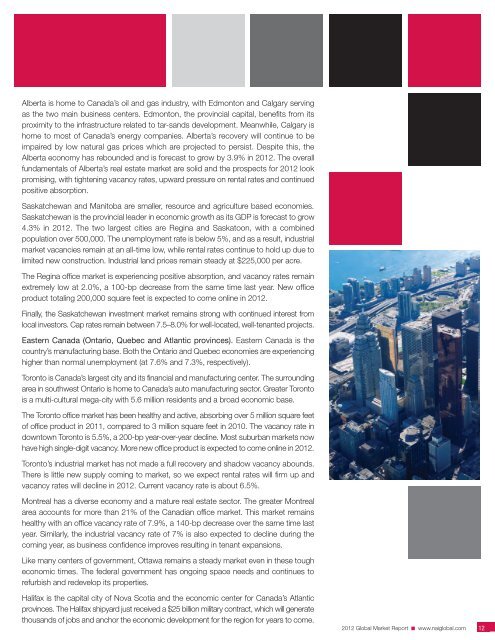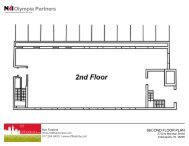2012 Global Market report - NAI Global
2012 Global Market report - NAI Global
2012 Global Market report - NAI Global
You also want an ePaper? Increase the reach of your titles
YUMPU automatically turns print PDFs into web optimized ePapers that Google loves.
Alberta is home to Canada’s oil and gas industry, with Edmonton and Calgary serving<br />
as the two main business centers. Edmonton, the provincial capital, benefits from its<br />
proximity to the infrastructure related to tar-sands development. Meanwhile, Calgary is<br />
home to most of Canada’s energy companies. Alberta’s recovery will continue to be<br />
impaired by low natural gas prices which are projected to persist. Despite this, the<br />
Alberta economy has rebounded and is forecast to grow by 3.9% in <strong>2012</strong>. The overall<br />
fundamentals of Alberta’s real estate market are solid and the prospects for <strong>2012</strong> look<br />
promising, with tightening vacancy rates, upward pressure on rental rates and continued<br />
positive absorption.<br />
Saskatchewan and Manitoba are smaller, resource and agriculture based economies.<br />
Saskatchewan is the provincial leader in economic growth as its GDP is forecast to grow<br />
4.3% in <strong>2012</strong>. The two largest cities are Regina and Saskatoon, with a combined<br />
population over 500,000. The unemployment rate is below 5%, and as a result, industrial<br />
market vacancies remain at an all-time low, while rental rates continue to hold up due to<br />
limited new construction. Industrial land prices remain steady at $225,000 per acre.<br />
The Regina office market is experiencing positive absorption, and vacancy rates remain<br />
extremely low at 2.0%, a 100-bp decrease from the same time last year. New office<br />
product totaling 200,000 square feet is expected to come online in <strong>2012</strong>.<br />
Finally, the Saskatchewan investment market remains strong with continued interest from<br />
local investors. Cap rates remain between 7.5–8.0% for well-located, well-tenanted projects.<br />
Eastern Canada (Ontario, Quebec and Atlantic provinces). Eastern Canada is the<br />
country’s manufacturing base. Both the Ontario and Quebec economies are experiencing<br />
higher than normal unemployment (at 7.6% and 7.3%, respectively).<br />
Toronto is Canada’s largest city and its financial and manufacturing center. The surrounding<br />
area in southwest Ontario is home to Canada’s auto manufacturing sector. Greater Toronto<br />
is a multi-cultural mega-city with 5.6 million residents and a broad economic base.<br />
The Toronto office market has been healthy and active, absorbing over 5 million square feet<br />
of office product in 2011, compared to 3 million square feet in 2010. The vacancy rate in<br />
downtown Toronto is 5.5%, a 200-bp year-over-year decline. Most suburban markets now<br />
have high single-digit vacancy. More new office product is expected to come online in <strong>2012</strong>.<br />
Toronto’s industrial market has not made a full recovery and shadow vacancy abounds.<br />
There is little new supply coming to market, so we expect rental rates will firm up and<br />
vacancy rates will decline in <strong>2012</strong>. Current vacancy rate is about 6.5%.<br />
Montreal has a diverse economy and a mature real estate sector. The greater Montreal<br />
area accounts for more than 21% of the Canadian office market. This market remains<br />
healthy with an office vacancy rate of 7.9%, a 140-bp decrease over the same time last<br />
year. Similarly, the industrial vacancy rate of 7% is also expected to decline during the<br />
coming year, as business confidence improves resulting in tenant expansions.<br />
Like many centers of government, Ottawa remains a steady market even in these tough<br />
economic times. The federal government has ongoing space needs and continues to<br />
refurbish and redevelop its properties.<br />
Halifax is the capital city of Nova Scotia and the economic center for Canada’s Atlantic<br />
provinces. The Halifax shipyard just received a $25 billion military contract, which will generate<br />
thousands of jobs and anchor the economic development for the region for years to come.<br />
<strong>2012</strong> <strong>Global</strong> <strong>Market</strong> Report n www.naiglobal.com<br />
12













